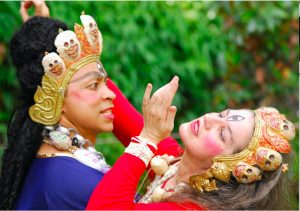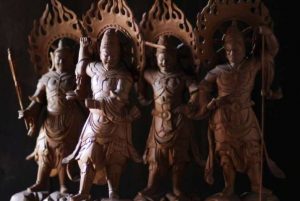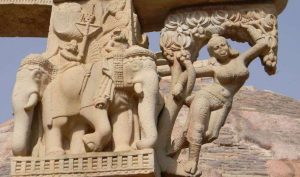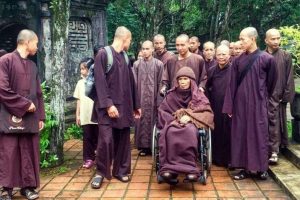
The combination of black sumi ink and white paper has been an artistic staple of Zen Buddhism for centuries. Whether working in the realm of painting or calligraphy, artists throughout East Asia have brushed ink onto paper, varying the amount of water mixed into the ink to create tonal gradations of black and grey, and producing monochrome text and images that balance light and dark, and harmonize the material and the void. The effect is not simply aesthetic, but also deeply spiritual, since the philosophy of Zen—or meditational—Buddhism emphasizes emptiness and impermanence, concepts expressed in Japanese as ku (空), meaning “sky” or “void,” or shogyou mujo (諸行無常); “everything is transient and nothing remains the same.” These concepts lie at the heart of the paintings and sculptures of Yoshio Ikezaki, an artist who has lived and worked in both Japan and the United States for several decades. Trained as a traditional Japanese paper maker and able to grind his own ink, Ikezaki has such a profound understanding of his artistic materials, and their relationship with the natural world and its energetic forces, that they have become visual expressions of the most complex paradoxes of Japanese spirituality.
Ikezaki’s ink painted landscapes are reminiscent of the spontaneous haboku (“flying white”) landscapes of early Chinese and Japanese Zen painters, whose scenes of mountains, rivers, and islands were often formed with spontaneous ink washes rather than dark strokes or outlines. Ikezaki applies ink to the surface of the paper with a brush and then harnesses his own ki energy to manipulate the flow of the ink over the paper’s wetted surface. According to ancient Chinese Daoist philosophy, ki, known in Chinese as qi or chi, is the life force or energy that permeates everything in the universe and flows through and around our bodies. In order to control his own ki, Ikezaki practices meditation and concentration to unite his mind, body, and spirit so that his intention and his intuition can act in harmony with each other. “Ki is the essential element for my artwork,” Ikezaki explains. “I use water as an active force to control the ink on wet paper. Ki serves to transform my will and intention to control the ink movement over the space of paper, for both even distribution and intended and/or accidental collisions of ink and water.”

The resulting paintings, particularly in his Timeless Auras series that he has been working on since 2003, suggest that his ki is also acting in harmony with the ki of the universe. Without even touching the brush to the paper, Ikezaki engenders misty mountains, cascading waterfalls, and tree-lined lakes. The landscapes are subtle yet haunting, soaked not only in water and ink but also in the quality that the Japanese refer to as yugen, meaning “mysterious” or “suggestive.” There appears to be much lying beneath the calm surface of the scenes, beneath the lake or hidden among the trees. This effect is even more pronounced in the 2015 painting Reflection of Stormy Sky 667, in which dense branches of an almost electric light appear to hover over a pine forest and are reflected on the surface of the vast lake in the foreground. A great energy inhabits and animates the landscape—one formed by Ikezaki but clearly also belonging to the universe. In such paintings, the image of water and ink flowing over the surface of the paper suggests the fluidity of the substantial, the passage of time and shougyo mujo; the impermanence of all phenomena.
Although Ikezaki’s paintings are powerful expressions of Zen Buddhist concepts and artistic forms, it is in his sculptures where his skills as an artist, and as a spiritual being connected with the natural world, can be more fully experienced. Ikezaki began his training as an artist in the United States in the 1970s, but returned to Japan in 1980 to study paper making with master paper makers Shigemi and Shigeyuki Matsuo in in Yame, Fukuoka, on the island of Kyushu, close to where he was born. He spent six years learning from them how to create traditional Japanese washi paper using kozo, or paper mulberry fibers. He became highly skilled at controlling the thickness and distribution of these fibers within each sheet of paper. However, after years of making paper and using it as a surface for painting, he came to see washi as a medium for artistic expression and began layering sheets of his paper, soaking them in ink and modeling them into organic forms reminiscent of the gnarly bark of ancient trees or of molten lava, as in his series of abstract sculptures entitled The Earth Breathes, which he has been creating since 1989. For these works too, he explains, “Ki is also my concentration of muscle power, my will, and my intuition, which I depend on to form my sculpture.”

In the early 2000s, Ikezaki was studying the Heart Sutra (Sanskrit: Prajñāpāramitāhṛdaya; Japanese: Hannya Shingyo), one of the most popular texts in Mahayana Buddhism. This exploration inspired him to examine some of the ideas expressed in the sutra in his washi sculptures, in particular the concept that form itself is emptiness. As part of his The Earth Breathes series, he formed books out of densely layered sheets of his washi paper, which he not only infused with sumi ink but also inscribed with text from the sutra, barely visible against the dyed paper. Through the creation of these works, he gained an understanding of the meaning of the text. “Emptiness does not differ from form. Form itself is emptiness. This is Heart Sutra. Ku is the state of selflessness separated from persistence.”
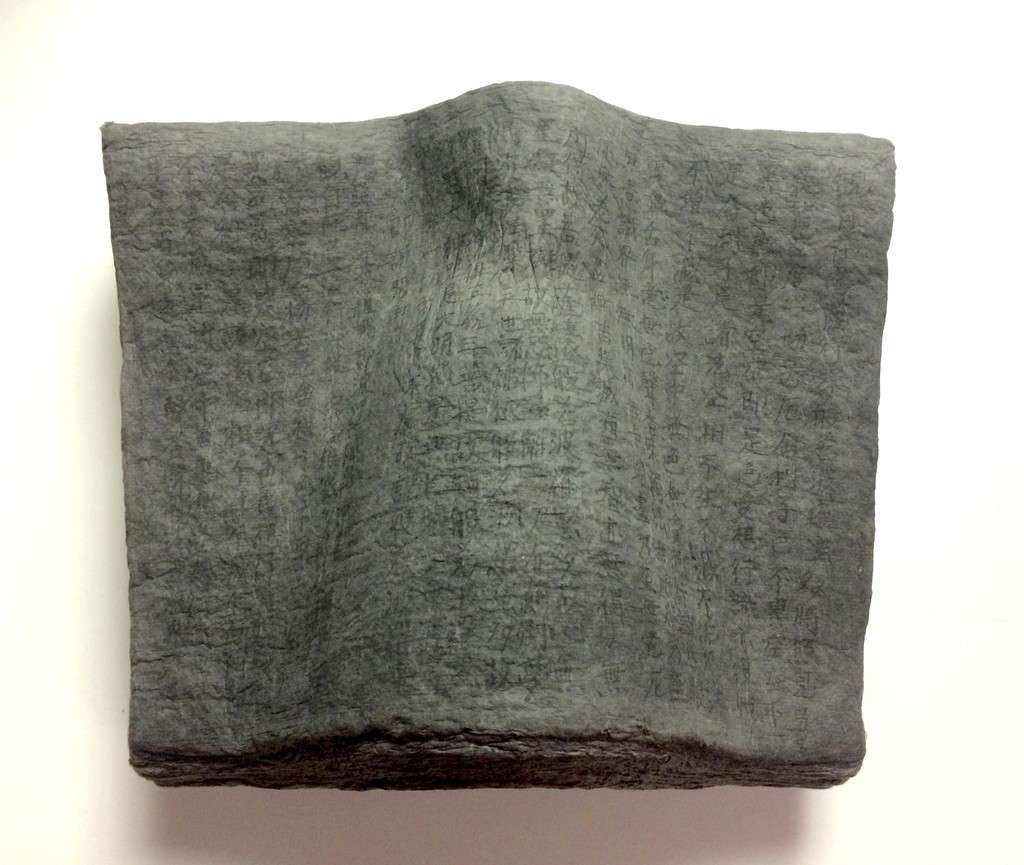
In appreciation of his artistic exploration of this sutra, Ikezaki was invited to display his work at Shoukoku-ji—the head temple of the Rinzai Zen school in Kyoto. His book sculptures were displayed at the edge of six large, tatami-mat rooms in the monks’ quarters. Sitting facing the walls of the room, as Zen monks are required to do during meditation, these dark, semi-abstract layerings of ink-infused paper imply both an absence and a presence, a timelessness and a formlessness that are suggestive of the concept of ku and are at the very core of Zen Buddhist practice.


